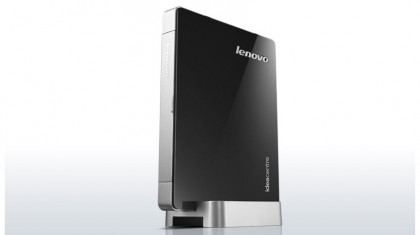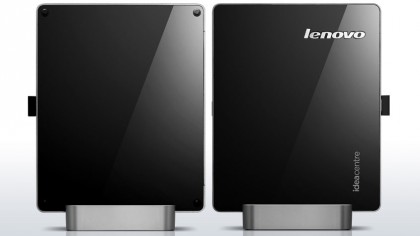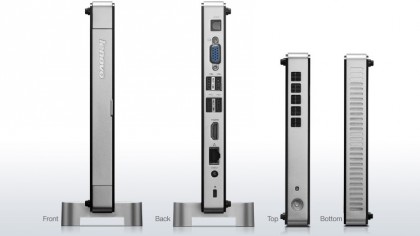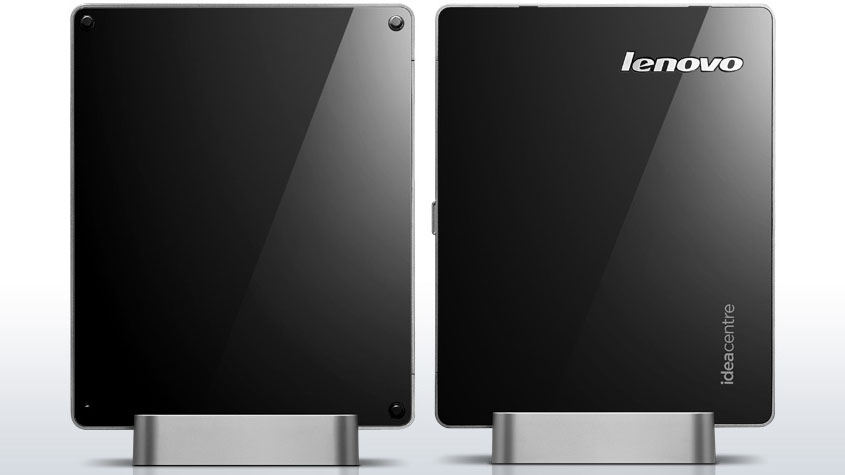TechRadar Verdict
Pros
- +
Versatile design
- +
Excellent connection options
- +
Plenty of RAM
- +
Capacious hard drive
- +
VESA mountable
Cons
- -
Uninspiring CPU performance
- -
Poor graphics prowess
- -
Initially sluggish
- -
Not upgradeable
Why you can trust TechRadar
The world of the humble PC has changed. Where once the term 'desktop PC' conjured up images of a certain size and shape, these days the term doesn't necessarily relate to any particular form factor or use, as the Lenovo IdeaCentre Q190 and its ilk emphasise.
Small desktop PCs have the advantage over laptops in their ability to connect to a large monitor or TV, with budget 24-inch, 1080p screens such as the AOC E2462VWH selling for only around £120/US$150. Alternatively, 1080p televisions in a variety of sizes can be had at bargain prices too.
The Lenovo IdeaCentre Q190 is a tiny computer that you can hide out of sight behind just such a monitor or TV screen, with a full price of £429.99 / US$419 (around AU$725) for an Intel Core i3 model.
Where Lenovo's other slim machines are soberly designed to ensure that they don't look out of place in an office, such as the Lenovo M92p, the Lenovo IdeaCentre Q190 is far more like something you'd see next to a TV or in a more designer-like place of work.
The Lenovo IdeaCentre Q-series PC is thin, stylish and looks more like a router than it does a whole computer. This is of course assuming you want the device on show. If not, it's quite easy to use the supplied VESA mount to sneak it around the back of your screen and have it completely out of sight.
Of course the Lenovo IdeaCentre Q190 isn't the only small form factor PC to be available right now, with plenty of manufacturers producing machines that are surprisingly tiny. Acer for instance has had its Revo line around for a long time, and has been honing its offerings for a variety of markets - including for use as a set-top box.
Gigabyte has recently released the Brix, while the Zotak ZBox even manages to pack some gaming capabilities into its stylish shell. Intel has also made its presence known in this market, with its tiny NUC range of barebones kits making for some intriguing possibilities. And of course, there's always Apple's Mac mini.
Specifications

The internal makeup of the Lenovo IdeaCentre Q190 is fairly basic, relying as it does on slightly older technology, but it's still capable enough for most basic uses.
The Core i3 -2365M 1.4GHz processor in the model we tested may be two generations behind the latest Haswell chips, but it can still handle four concurrent threads and happily runs the latest applications smoothly enough.
The cheaper (£299.99 / US$299) specced version of the Lenovo Q190 runs on an Intel Pentium ULV 2127U processor at 1.9GHz.
Lenovo has paired the Intel chip, which is also responsible for the graphics capabilities of the machine, with 4GB of PC3-10600 DDR3 RAM. The tiny chassis is home to a 1TB 5,400rpm hard drive and offers support for 802.11b/g/n wireless connectivity as well.
The capabilities of the internal components are nearly as important as the expansion options of these small form factor machines, and many a manufacturer has come unstuck here, simply because they haven't put enough USB ports on the device.

Lenovo hasn't fallen here though, and the IdeaCentre Q190 boasts a total of six USB ports for your peripherals and expansions, three of which are USB 3.0 type. You can of course add a USB hub if you need more options, but at least this isn't necessary just to get a useful machine.
The two USB 3.0 connections can be found hidden behind a flap on the front edge of the machine, along with microphone and headphone 3.5mm jacks and a memory card reader. This memory card reader accepts SD/SDHC/SDXC and MMC/MS/MS Pro cards, making it a good companion for photographers.
The rear of the system is home to four high-speed USB 2.0 ports, which we'll admit are a little cramped together, but should see you fine for everything but the chunkiest of high-capacity USB flash drives.
To the right of the USB ports there's a legacy display adaptor, a VGA port, next to to the SPDIF digital audio connector. The HDMI port and RJ45 wired Ethernet connector are positioned on the other side of the bank of USB ports.
On the far-left of these ports you'll find a Kensington Lock - which is useful given the pocketable size of the machine if you're looking to use it in the office - along with the power connector, which connects to a standard laptop-like power supply.

The final points of interest can be found on the left-hand edge of the Lenovo Q190 - or the top, depending on your preferred orientation. These are the power button and hard drive activity light. The other edges have exposed grilles to help keep the machine cool.
Performance
As mentioned, the internal components of the Lenovo IdeaCentre Q190 aren't going to challenge a full desktop PC or indeed many laptops - and this notion isn't betrayed by the benchmarks. The Intel Core i3 processor may be capable of handling four threads at the same time, but given that it is only rated at 1.4GHz, it lacks the basic raw power.
Benchmarks
Cinebench R11.5 - OpenGL: 6.86fps, CPU: 1.34pts
3DMark 2013 - Ice Storm: 18,555, Cloud Gate: 1,794
PCMark 7 - Index: 1,895
The CPU index of 1.34 in Cinebench R11.5 demonstrates this ably enough, lagging behind many simpler laptops, even those at the lower end of the price scale - and remember that such machines come with a screen attached as well.
The integrated Intel HD 3000 graphics fare slightly better, since this isn't the bargain basement graphics core from Intel, but actually the top-end of the previous generation. In real terms this means that some simpler games are going to be playable so long as you can turn the settings down to the absolute minimum.
The new 3DMark 2013 benchmark test does prove that there is hope for this machine, and while it may not be able to run the most recent tests, the basic Ice Storm benchmarks, which lack the fancy lighting and clever effects of more recent games, do run smoothly - at 93fps in the first test, and 82fps in the second.

The Lenovo Q190 is hardly a gamer's computer, we'll concede, but it does mean that you have the option to put the PC to other uses now and again if the moment takes you.
Having said all that, when it comes to using the computer for more sober tasks - simple office work, browsing or editing photos - it handles the workload well and barely breaks into a sweat. When you do push it, as with the Cinebench tests, the internal fan does make itself heard, but normally it's no louder than most laptops.
As ever with a fresh install of Windows 8, we did find the PC initially sluggish, but once Microsoft's optimisation routines kick in, it settled in to being quite a responsive system - which is helped by that healthy 4GB of RAM.
It's in the usability stakes where the Lenovo IdeaCentre Q190 impresses the most, though. Plug it in, connect whatever devices you need and you're up and running in minutes. Being able to plug in all manner of USB drives, peripherals and memory cards without reaching for a third-party unit makes for a great little companion for many tasks.
If you need serious performance, then you're going to have to pick up a machine with faster, more-up-to-date components. But if your needs are more straightforward, then there's enough performance from the Core i3 processor to keep you happy. There are certainly no problems when playing back HD videos.
Verdict
Is there room for simple desktop PCs in a market dominated by laptops and by next-gen consoles? Can the Lenovo IdeaCentre Q190 stand out? These were questions we had before we even plugged in this machine, and after testing they're still the questions that ultimately define whether it will be a success or not.
Lenovo has certainly dodged some of the pitfalls that such machines stumble on, mainly on the connectivity front, but at the same time it doesn't quite do enough to make it the must-buy device it could have been.
We liked
The slim, compact design of the Lenovo IdeaCentre Q190 makes for a versatile desktop PC without the usual necessary investment in space. With the supplied bracket you can potentially hide the system completely out of the way, although leaving it on your table isn't the worst idea either. The fact that it has more than enough USB ports, a memory card reader and versatile connection options also impresses.
Whether you're looking for a machine to slide next to your television, or a simple system to use as a desktop, then it handles its task amiably for a system that rolls in at £430 / US$420 (around AU$725). Having said that, the Core i3-2365M processor is a capable enough slice of silicon, and while it is a couple of generations behind the times, it still manages to tick the main boxes that matter.
We disliked
This machine would be more impressive if it were packing the latest generation of Haswell processors, since this would improve the raw CPU power and the performance from the graphics subsystem.
And even the though the power requirement is less vital in a desktop PC, the reduced thermals could help keep the fan noise levels down a little more.
Final verdict
Anyone looking for the fastest PC ever built is going to be sorely disappointed with the performance on offer from the Lenovo IdeaPad Q190, but other than that, there's a lot to like here.
It's versatile, well-priced and offers up a good selection of ports. The small footprint means it's just as well-placed next to your television as it is as a discrete desktop, and the sizeable hard drive covers many uses too.
